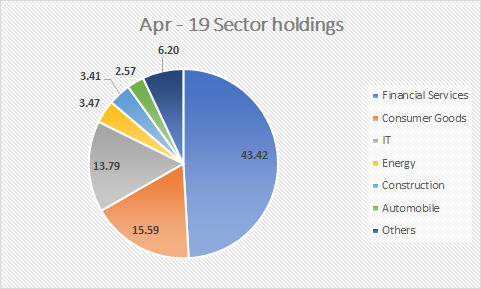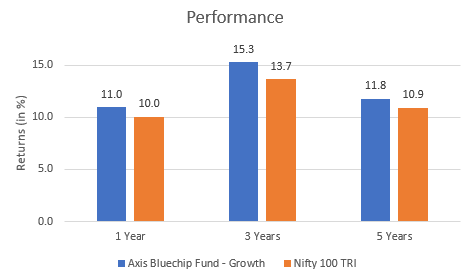What:
A largecap fund with a focused approach
Why:
- Props up returns by taking tactical calls
- Contains downsides and delivers over the long term
Whom:
Moderate risk investors with a long-term view
Axis Bluechip (previously called Axis Equity) delivered 12.8% returns in the last 5 years against 12% delivered by benchmark index Nifty 100 TRI. At a time when largecap funds have been struggling to outperform the benchmark, the fund’s concentrated approach and dynamic calls have given it an upper hand. The fund has seen ups and downs, prolonged streaks of underperformance and periods of flashy returns. But what stands out is its long-term performance. Despite periods of underperformance, the fund still scores on long term metrics. Recent changes in its strategy have helped improve returns tremendously.
Change in strategy
After sustained underperformance from 2016 to most of 2017, the fund has recovered. It has been gradually morphing into a concentrated fund from being a relatively diversified fund. There have been changes in majorly three aspects:
- Concentration – The fund currently has a portfolio of 23 stocks with the top 5 holdings contributing to over 40% of the portfolio. The portfolio has shrunk by half from 3 years ago. HDFC Bank is its top holding with a near 10% exposure. Three years ago, the stock was still top holding but with an exposure of around 8%. Even though the fund wasn’t categorised as a focused fund, its strategy follows a focused approach with high conviction bets.
- Asset allocation – The fund has reduced midcaps and upped its debt exposure. From late 2016 till 2018, the fund has been booking out of midcaps. During the strong midcap rally in 2017, the fund was reducing exposure. From exposure of 14% at the beginning of that year, the fund brought it down to 7% by Jan 2018. Funds like SBI Bluechip and ABSL Frontline Equity held around 14% in midcaps during this period. This is one of the reasons why its performance paled next to its peers. However, it benefitted when the rally ended because it was booking profits through the highs. The fund also began taking cash calls and started increasing cash from early 2018. The fund held up to 18% in debt in early 2019 compared to a steady exposure of 1-3% till 2016. This essentially reduced the overall risk of the fund.
- Tactical Approach – The fund became more tactical in its approach, deftly moving in and out of stocks. Post-2017, its portfolio turnover almost tripled from levels of 50-60% to 150-180% showing its change in strategy. For example, it started booking profits in Maruti Suzuki in early 2018 when the stock was at its peak. And since then, gradually reduced exposure there. Where it saw potential, it managed to time the entry well. TCS and Bajaj Finance are such stocks where the fund began hiking exposures in early 2018 and caught the rally. Even where stocks were held for a long time, the fund regularly booked profits and made fresh entries.
Portfolio

The fund’s portfolio has benefited from the narrow rally we have been seeing. It has over 40% exposure to banking and financial services while having very small exposures to auto and energy stocks which have fallen out of favour. The fund deftly changed exposures to different sectors and stocks while booking profits during rallies and averaging out costs during slumps. The fund took right sector calls, be it picking up IT or steady pruning of auto exposure in early 2018. It also benefited from the FMCG rally in 2018 where it always maintained a good exposure.
It also ventured into newer stocks by participating in IPOs, but was quick to let go if it didn’t see the potential. SBI Life Insurance and HDFC Life Insurance were held for all of two months post their listing. On the contrary, the fund bought into Avenue Supermarts post the IPO and has been increasing exposure.
Performance
Largecaps as a category have largely been trailing the index. In the last 5 years, based on 1-year rolling returns, funds have beaten Nifty 100 TRI only 43% of the time. Axis Bluechip has managed to outperform the index 70% of the time, only next to Mirae Asset Large cap. Even though the fund went through periods of underperformance, it made up for it. If we look at longer-term returns, 3 and 5 years, the fund still beats the benchmark.

Returns as of 1st July 2019.
Despite the fund taking concentrated calls and having a high portfolio turnover, it is relatively less volatile. Standard deviation, a measure of volatility, is lower than the category average. This aids the fund in producing better risk-adjusted returns. Based on rolling 1-year returns over the last 5 years, the Sharpe ratio of the fund is second best among its peers.
The fund also contains downsides much better than other funds in the category. Looking at 1-month returns for the last 5 years, the downside capture ratio stood at 89%, worse than only 2 funds. This characteristic can also be observed from how the fund performed in different market cycles. Since its launch in 2010, markets saw two major declines – in 2011 and 2015. The fund lost lesser than the category in both instances.
Axis Bluechip is suitable for moderate risk investors looking for long term options (5 years or more). It can be used to build core portfolios as it will lend stability. The fund is managed by Shreyash Devalkar since Nov 2016 and has an AUM of ₹5,144 crore.







